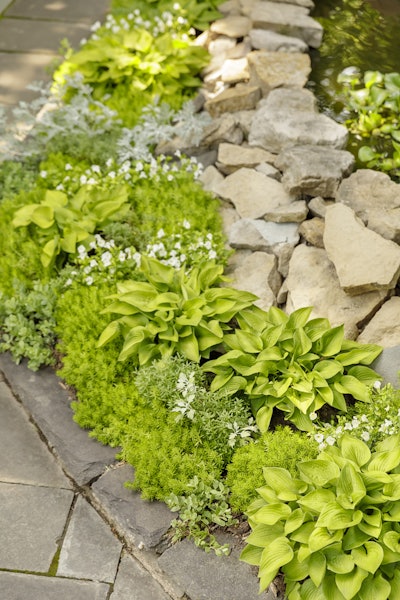 Photo: Proven Winners
Photo: Proven WinnersWhen designing a stunning landscape for your customer, there are many options available when choosing landscaping plants, such as form, fragrance and texture.
Plant textures come in varieties ranging from fine and delicate to course and bold, and the word texture doesn’t just refer to the physical feel of the plant. Texture serves as an eye-catcher in the space and can also affect how a plant interacts with lights and shadows in a landscape. It can also add depth to an area that might originally be flat.
When creating texture in your customer’s garden, don’t forget to take into consideration how all the senses will be addressed when walking through the space, especially sight, smell and touch.
Engage the senses
Sight is the first sense that comes to mind when designing your customer’s landscape, and it is also one of the easier ones to please. When working to create visually stunning textured designs, the most basic rule to follow is to try and pair fine foliage with bold foliage.
Another idea to try is to mix amorphous plants with more graphic ones, as each one will stand out more distinctly when placed beside each other. Also, keep in mind that textures don’t have to be messy or over the top. Take a combination that fits well together and repeat the pairing throughout the area to keep that continuity going, which will help keep the space looking uniform and classy.
The natural instinct of wanting to touch a beautiful plant is something you should also take advantage of when choosing textured plant varieties. Adding in masses of fluffy, fuzzy, feathery or soft plants where they will either invite customers to stop and touch them or simply have them touch their ankles as they pass will add another enjoyable experience to the landscape.
Balance and depth
The key when adding in texture is to keep it balanced. Too much of one kind of texture in a space can throw off it off balance, which means that mixing textures to ensure they complement and highlight each other is important.
Don’t be afraid to combine plants that contrast each other, such as putting a wide-leaf and small-leaf plant together to see how they look. Putting plants together that have blooming spikes with one that has foliage spikes can create a unique look that is sure to make your customers stop and take notice.
When attempting to create depth in the space, remember that bolder textures will make the plants appear closer than they are, and finer textured ones will seem farther away.
If your customers have a smaller bed and want to make it seem larger, take bolder and course textured plants and put them in the front of the bed. Layer that with medium textured plants in the middle section and finish it off with fine textured plants at the back. This creates a layered and thicker look, which can trick the eye into thinking the space is larger than it really is.
Undertones and existing plants
In most formal gardens, structure is important and adds interest to the landscape design, but don’t forget that texture can do the same thing.
Having one area with smooth hedges right next to blooming bushes and trees contrasts the light and airy feel with the neighboring solid and straight texture.
When you’re combining textures, it’s a good rule of thumb to start off with plants that have similar undertones. It gets a little tricky when trying to mix differing undertones into the same area but sticking with similar colors can still offer a decent variety.
One of the simplest ways to add texture to a space is to bring in new plants to add contrast to the existing texture. Take stock of the area and see how much space is being taken up by leaves and flowers already, as well as the patterns they already have. After that, it’s as simple as pairing these plants with colors and textures that will pop.
If there are already multiple varieties of flowers in the area, consider adding in some bolder, darker colored foliage to add the needed contrast. In the summer months, flowers tend to carry more impact for texture, so take advantage of those plants and consider adding in a few more to bring out more of that existing texture.












